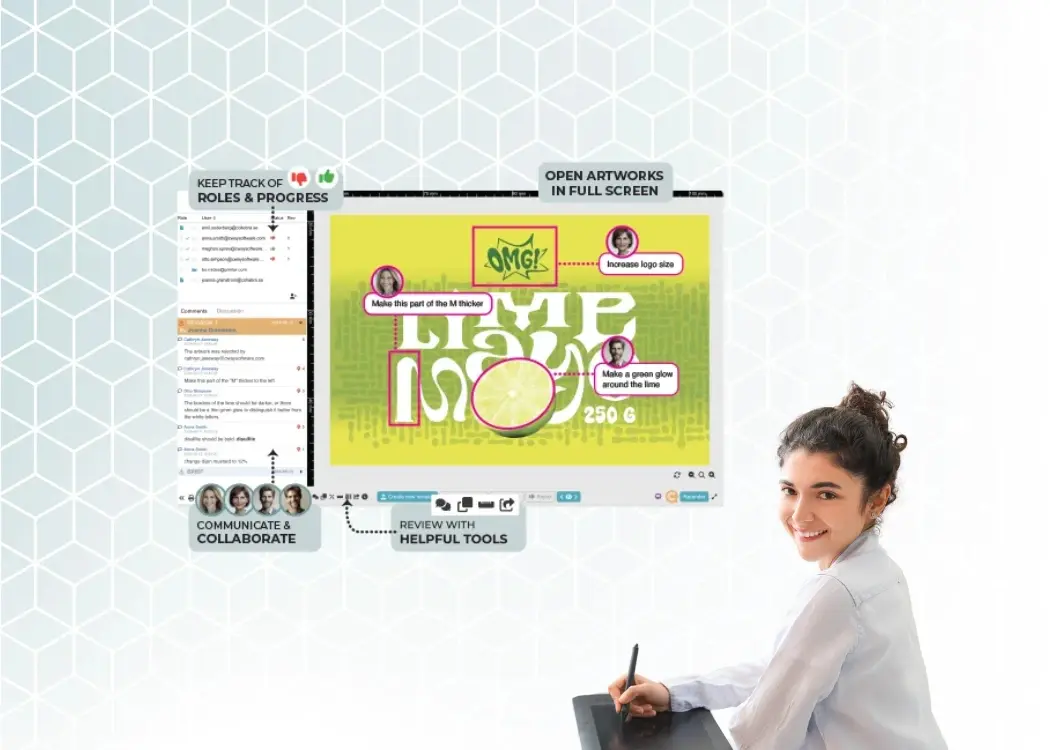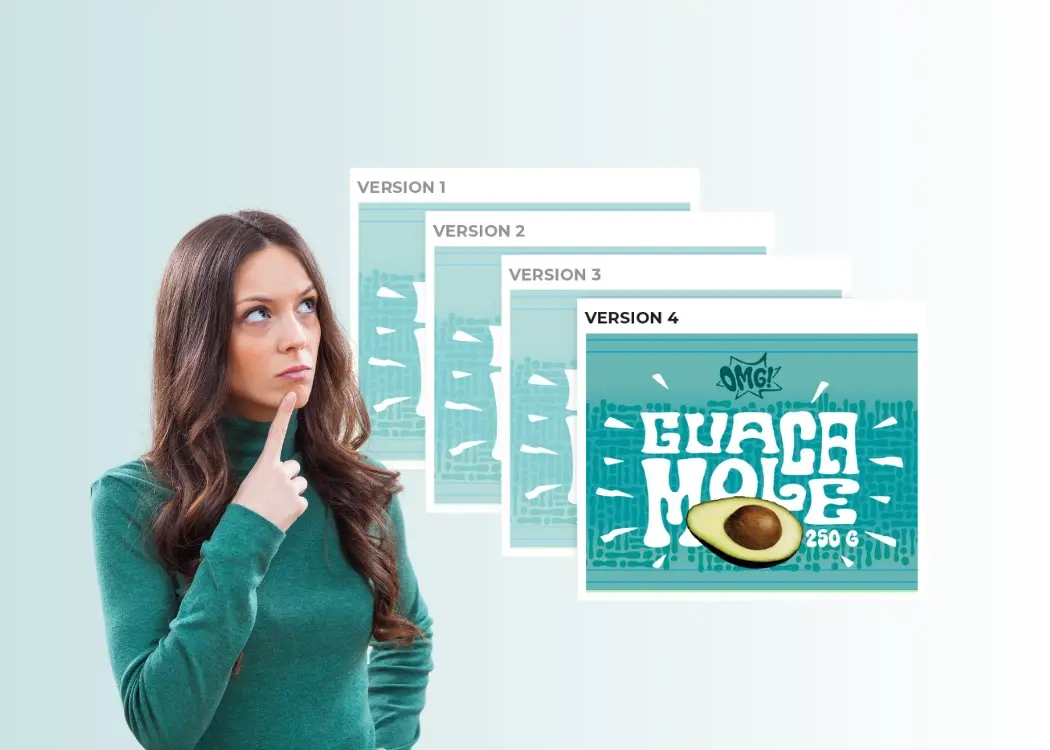Upgrade packaging design process with smart artwork workflow software
If your team struggles to manage packaging artwork across multiple stakeholders, you’re not alone. In this article, we’ll explore how artwork...
4 min read
 Ekaterina Skalatskaia
:
June 2, 2025 at 8:45 AM
Ekaterina Skalatskaia
:
June 2, 2025 at 8:45 AM

Imagine spending months preparing for a product launch — only to delay shipping because the barcode was placed incorrectly. Or having to reprint thousands of cartons due to a missing allergen statement. These aren’t rare disasters — they’re regular side effects of broken artwork processes.
If you’ve ever tried to coordinate designers, marketers, legal, QA, and external agencies around packaging artwork, you know the pain: endless email threads, version mix-ups, missed deadlines, and stressful last-minute changes.
This article breaks down why packaging artwork management is so complex — and how to take back control. You’ll learn how to avoid common pitfalls, apply industry best practices, and discover how Cway helps teams move from chaos to clarity.
Packaging artwork management is the process of creating, reviewing, approving, and delivering the visual assets and labeling information that appear on a product’s packaging. It touches nearly every part of the business: marketing, design, regulatory, quality assurance, production, and logistics.
When your product range spans dozens (or thousands) of SKUs across multiple markets, packaging artwork becomes a high-stakes operation. You're juggling:
Multiple packaging formats (boxes, labels, sachets, shrink wraps)
Multilingual requirements
Legal disclaimers and regional regulations
Marketing claims and design consistency
In regulated industries like pharma or food, a small mistake can result in recalls, regulatory fines, or serious brand damage.
Here’s how a standard workflow looks:
Briefing – Marketing or product teams define requirements: flavor, region, claims, promotions.
Design – Internal designers or agencies create the layout and visuals.
Review – Legal, regulatory, and quality teams check for compliance.
Approval – Stakeholders sign off (often across multiple time zones).
Handoff – Final artwork goes to print or production.
Each stage creates an opportunity for mistakes, especially when managed across disconnected tools like email, Excel, or Dropbox.
Struggling to keep track of all your packaging tasks, deadlines, and feedback? Learn how to get full visibility over your entire process by tracking your packaging artwork tasks with a centralized system. It’s the easiest way to stay on top of everything — without the stress.
Simplify the way your design, marketing, and regulatory teams collaborate. With real-time updates and full version control, nothing falls through the cracks.
Packaging artwork projects are like juggling flaming torches — in a windstorm. Here are the most common sources of stress:
Designers, marketers, product managers, legal reviewers, QA specialists — all have input, and often conflicting priorities. Without clear roles and visibility, things slip through the cracks.
Example: A design team updates a layout based on marketing feedback — but forgets to include new regulatory wording. QA flags it late in the process, and everything stalls.
Version 3_Final_FINAL_v2.pdf — sound familiar? Without proper version control, it's impossible to know which file is the latest. Teams waste hours cross-checking edits or, worse, approve the wrong version.
Approvals often rely on people manually forwarding files, chasing feedback, or waiting for that “urgent” email to be read. This slows everything down and puts pressure on production timelines.
In regulated sectors, a packaging error isn’t just embarrassing — it can be a legal issue. When audit trails are missing or responsibilities are unclear, accountability becomes a problem.
Packaging errors aren’t just inconvenient — they’re expensive. From missed claims to misprints, small oversights can cost big money. See why leading brands are turning to experts, and how packaging artwork process consulting saves millions in rework, delays, and compliance issues.
1 in 3 Packaging Errors Are Due to Version Confusion
Cway’s Compare tool helps you catch issues before they go to print
Let’s look at how top-performing teams manage packaging artwork more efficiently — without burning out.
Ditch the patchwork of email, shared drives, and spreadsheets. A dedicated artwork management platform keeps everything — briefs, files, comments, approvals — in one place.
Why it works: Everyone sees the same information, and you get a clear audit trail of who did what, and when.
Set up automated reminders for reviewers. Trigger workflows when certain steps are completed. Assign tasks based on roles.
Example: When a designer uploads a new version, Cway can automatically notify the QA lead and legal reviewer — no chasing needed.
Instead of manually checking what’s changed between two files, use visual diff tools that highlight differences instantly. This helps catch even tiny changes in text, layout, or placement.
Real-world tip: Don’t rely on memory — even one-word edits can cause regulatory issues if missed.
Create pre-approved templates for each packaging format or region. It reduces back-and-forth and ensures compliance from the start.
Bonus: It’s easier to onboard new team members when there’s a library of "how we do things."
Every decision, every version, every comment — stored and searchable. When regulators ask for an audit trail, you’ll have it ready in seconds.
Manual follow-ups and scattered communication slow down your projects. Discover how automated artwork management helps you streamline reviews, speed up approvals, and eliminate the back-and-forth — all while staying fully in control.
Automate repetitive tasks, reduce back-and-forth, and keep every stakeholder informed — all without switching between tools.
✅ No credit card required
✅ Full access
✅ Personalized onboarding session available
Cway was built specifically to solve the unique headaches of packaging artwork. Here's how it works:
Track every artwork project with tasks, deadlines, and assigned roles. Get full visibility from brief to final approval. Everyone knows what’s next — and when.
Cway’s Compare tool lets you overlay artwork versions and instantly highlight visual or textual changes. It’s like “track changes” for packaging — but better.
Set up structured approval chains with automated notifications and deadlines. Whether it's legal, regulatory, or marketing — everyone knows when it’s their turn.
Validate that artwork meets technical print specs before hitting the presses. No more late surprises from the print vendor.
Teams using Cway see:
30% faster project turnaround
70% fewer revision cycles
Near-zero versioning errors
If your artwork workflow still runs on spreadsheets and email chains, it’s time to upgrade. Find out how dedicated artwork workflow software helps teams work faster, catch more errors, and deliver flawless packaging — every time.

“Cway has brought clarity, speed, and structure. We save time, reduce mistakes, and make sure everyone involved—marketing, legal, quality—has the same information in one place.”
Sofia Wallsten,
Product Manager at Fria Bröd
Managing packaging artwork can feel overwhelming — especially when you’re coordinating multiple teams, tight timelines, and strict regulations. But it doesn’t have to be this way.
With the right approach and the right tools, the process becomes much easier to control. You get fewer surprises, fewer mistakes, and a smoother path from idea to shelf.
Cway helps you bring structure, clarity, and speed to every step — so your team can focus on what really matters: getting great products to market on time.

If your team struggles to manage packaging artwork across multiple stakeholders, you’re not alone. In this article, we’ll explore how artwork...
Managing artwork processes across multiple teams, versions, and approvals can quickly become chaotic and error-prone. Traditional methods often lead...

You’ve probably been there: 10 rounds of artwork edits, 4 people CC’d on a PDF, and a folder full of files named Final_v3_THIS_ONE_USE.pdf....